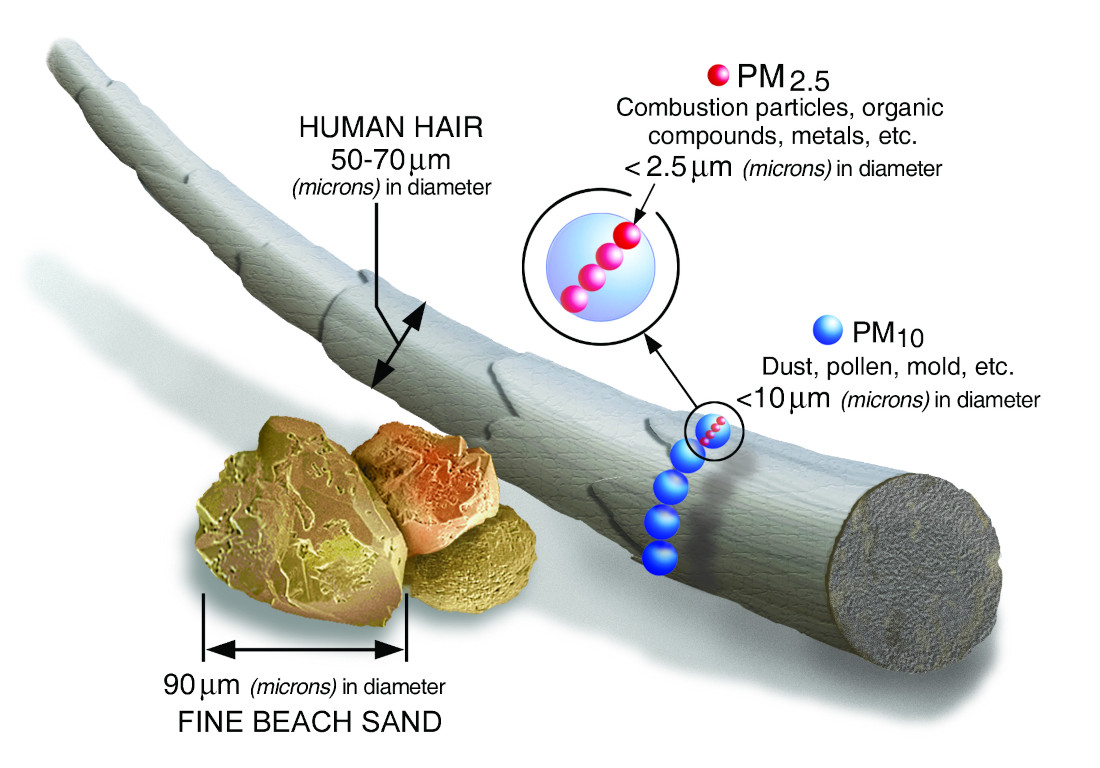Particulate Matter (PM) refers to tiny particles or droplets in the air that can be inhaled into the respiratory system. They are categorized by their size, which directly impacts their health effects and how they interact with air filtration systems. Here’s a detailed breakdown:
What is PM2.5?
- Definition: Particulate matter with a diameter of 2.5 microns (micrometers) or smaller.
- Size Comparison:
- About 1/30th the diameter of a human hair.
- Invisible to the naked eye, requiring a microscope to detect.
- Sources:
- Combustion processes (e.g., vehicle emissions, wood burning, power plants).
- Cooking and smoking indoors.
- Secondary particles formed from chemical reactions (e.g., sulfates and nitrates in the atmosphere).
- Examples:
- Fine soot from burning wood.
- Particles from vehicle exhaust.
- Aerosolized droplets in pollution.
What is PM10?
- Definition: Particulate matter with a diameter of 10 microns or smaller, including PM2.5 particles.
- Size Comparison:
- About 1/7th the diameter of a human hair.
- Can often be seen as dust or haze in the air.
- Sources:
- Dust from roads and construction sites.
- Pollen and mold spores.
- Particles from crushing or grinding operations.
- Examples:
- Dust stirred up by wind or vehicles.
- Pollen during allergy seasons.
- Mold spores from damp indoor environments.
What’s Between PM2.5 and PM10?
Particles between 2.5 and 10 microns (often called coarse particulate matter) are typically lumped into the PM10 category because:
- Regulatory Focus: PM2.5 and PM10 are tracked for their distinct health effects. Intermediate sizes are not separately categorized because their health risks overlap with those of PM10.
- Measurement Simplicity: Existing monitoring systems typically measure cumulative sizes (e.g., all particles up to 10 microns).
- Relevance to Health: Larger particles (over 2.5 microns) are generally less harmful since they are less likely to penetrate deep into the lungs.
Health Risks of PM2.5 and PM10
PM2.5:
- Penetration into Lungs: These fine particles can travel deep into the alveoli (air sacs) in the lungs.
- Health Effects:
- Respiratory Issues: Aggravates asthma and bronchitis.
- Cardiovascular Problems: Linked to heart attacks and strokes.
- Neurological Effects: Emerging research suggests links to cognitive decline and neurological disorders like Alzheimer’s.
- Premature Death: Associated with increased mortality from lung cancer and cardiovascular diseases.
PM10:
- Limited Penetration: Larger particles usually settle in the upper respiratory tract and are expelled through coughing or sneezing.
- Health Effects:
- Irritation: Causes nasal and throat irritation.
- Allergies: Pollen and mold spores can trigger allergic reactions.
- Respiratory Conditions: Can exacerbate pre-existing conditions like asthma, though less harmful than PM2.5.
Removing PM2.5 and PM10 from Indoor Air
1. HEPA Filters:
- Effectiveness: Can trap up to 99.97% of particles as small as 0.3 microns, including PM2.5 and PM10.
- Best Use: Pair with an air purifier in bedrooms or living rooms.
2. Activated Carbon Filters:
- Effectiveness: Can complement HEPA filters by adsorbing VOCs and gaseous pollutants, which often accompany PM2.5.
- Best Use: Combine with HEPA filters for comprehensive air cleaning.
3. HVAC Systems with Proper Filters:
- MERV Ratings: Filters with a MERV rating of 13 or higher can capture PM2.5 and PM10 effectively.
- Maintenance: Regular replacement ensures continued efficiency.
4. Ventilation:
- Natural Ventilation: Open windows during low-pollution times to allow fresh air exchange.
- Mechanical Ventilation: Use energy recovery ventilators (ERVs) or heat recovery ventilators (HRVs) to manage airflow.
5. Regular Cleaning:
- Vacuuming with HEPA Filters: Reduces the buildup of PM10 particles like dust and pet dander.
- Damp Dusting: Prevents dust from becoming airborne.
Why Focus on PM2.5 and PM10?
PM2.5 and PM10 are tracked because they represent:
- Health-Relevant Sizes: PM2.5 penetrates deep into the lungs, while PM10 affects the upper respiratory tract.
- Sources and Control: These particles originate from both indoor and outdoor sources, making them manageable with targeted strategies.
To better understand the regulatory standards and guidelines for controlling particulate matter pollution, visit the EPA’s page on setting and reviewing particulate matter standards.
Understanding PM2.5 and PM10, their health risks, and effective removal strategies is crucial for improving indoor air quality. By investing in high-quality air purifiers, maintaining proper





0 Comments